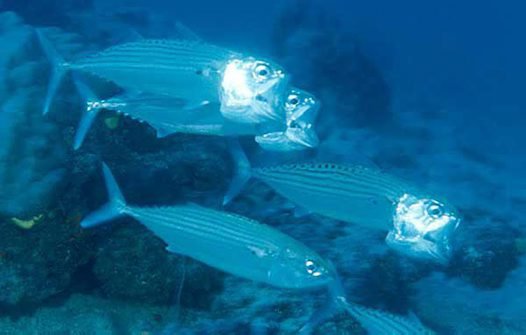Mouth Mackerel, Rastrelliger kanagurta (Cuvier, 1816)
Indian Mackerel, Long-jawed Mackerel, Rake-gilled Mackerel
Introduction
The Mouth Mackerel is blue-green above and silver on the sides. It occurs in tropical marine waters of the Indo-West Pacific.
Identification
The Mouth Mackerel has a fusiform body with a forked caudal fin. There are two dorsal fins followed by five finlets. The pectoral fins are very short. The species is blue-green above and silver on the sides. It has one or two rows of small dark spots on the upper sides. Below these are several gold to dark stripes along the body. There is a dark spot below the pectoral fin.

A school of Mouth Mackerel at a depth of 24m, "The Supermarket", south-west of the fringing reef, Mana Island, Fiji, April 2003.
Image: David Atkinson© David Atkinson
Habitat
It is a pelagic species.
Distribution
It occurs in tropical marine waters of the Indo-West Pacific. In Australia it is known from the central coast of Western Australia, around the tropical north and south to southern Queensland.
The map below shows the Australian distribution of the species based on public sightings and specimens in Australian Museums. Click on the map for detailed information. Source: Atlas of Living Australia.
Feeding and diet
The Mouth Mackerel often swims with its mouth open and gill rakers visible. The gill rakers strain plankton from the water.
Other behaviours and adaptations
It is a schooling species.
References
- Allen, G.R. 1997. Marine Fishes of Tropical Australia and South-east Asia. Western Australian Museum. Pp. 292.
- Collette, B.B. 2001. Scombridae in Carpenter, K.E. & V.H. Niem (Eds). FAO Species Identification Guide for Fishery Purposes. The Living Marine Resources of the Western Central Pacific. Volume 6. Bony Fishes part 4 (Labridae to Latimeriidae), estuarine crocodiles, sea turtles, sea snakes and marine mammals. FAO, Rome. Pp. iii-v, 3381-4218.
- Collette, B.B. & C.E. Nauen. 1983. FAO species catalogue. Vol. 2. Scombrids of the world. An annotated and illustrated catalogue of tunas, mackerels, bonitos and related species known to date. FAO Fish. Synop. No. 125: i-vii + 1-137.
- Hoese, D.F., Bray, D.J., Paxton, J.R. & G.R. Allen. 2006. Fishes. In Beesley, P.L. & A. Wells. (eds) Zoological Catalogue of Australia. Volume 35. ABRS & CSIRO Publishing: Australia. parts 1-3, pages 1-2178.
- Myers, R.F. 1999. Micronesian Reef Fishes. Coral Graphics. Pp. 330.
- Randall, J.E., Allen, G.R. & R.C. Steene. 1997. Fishes of the Great Barrier Reef and Coral Sea. Crawford House Press. Pp. 557.


